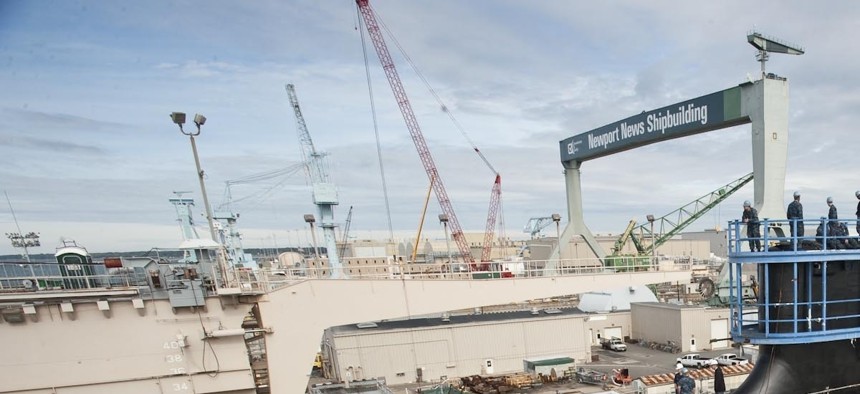
The USS Minnesota, a Virginia-class attack submarine under construction U.S. Navy/Newport News Shipbuilding
The U.S. Should Cut Its Nuclear Arsenal Before Sequester Does
The Pentagon needs to 'operate realistically' at the spending levels mandated by law and begin cutting back on its nuclear arsenal, a new report says. By Rachel Oswald
WASHINGTON -- A think-tank warned on Tuesday that if the Pentagon does not make moderate reductions to its nuclear-weapons programs and related missions, it could be forced to accept undesired changes to its atomic assets because of “sequestration” budget cuts.
The Stimson Center’s Defense Advisory Committee updated its proposal for a modified U.S. defense strategy -- a document it calls “Strategic Agility.” This plan is intended to help the Defense Department cut tens of billions of dollars in spending from its nuclear mission, weapons programs and other spending areas, and serve as an alternative to the $500 billion in decade-long sequestration reductions that started in March.
The Stimson Center in its new “Strategic Agility” report suggests changes to the U.S. nuclear stockpile -- including reductions to ICBMs, tactical nuclear weapons and planned purchases of ballistic-missile submarines -- that largely mirror recommendations the Washington-based nonpartisan organization offered last November.
Barry Blechman, chairman of the committee, told reporters that the center decided to update its 2012 recommendations after it “became apparent” this spring that the fiscal 2014 defense budget introduced by the White House and the responding legislation under consideration in the Senate and the House were not going to reverse the automatic, across-the-board sequestration cuts set in motion by the Budget Control Act of 2011.
The new defense strategy “says rather than permit sequester to happen again, it’s imperative to operate realistically at the budget level required by the legislation,” Blechman said on a Tuesday conference call. By making $50 billion in strategic cuts to defense spending, sequestration can be avoided “without harming our ability to defend vital U.S. national interests,” he continued.
Similar to the 2012 study, the updated spending strategy recommends retiring one-third of the country’s ICBM force for a reduction of 150 Minuteman 3 missiles and an estimated yearly savings of $300 million.
Tuesday’s study also reiterates the suggestion that the Navy order two fewer than the currently planned 12 new Virginia-class ballistic missile submarines, for a projected savings of $1 billion annually in the near-term and another $10 billion in the coming decade.
The report authors on Tuesday said President Obama’s administration should reconsider its plans to modernize the nation’s B-61 nuclear warhead and instead slash to unspecified numbers the stockpile of approximately 500 tactical weapons. Roughly 200 of the B-61 gravity bombs are deployed at the bases of European NATO allies.
“Defense savings from this measure would be roughly $100 million in 2015, but would grow substantially later in the decades,” the study asserts.
The Stimson Center continues to urge the development of theater missile defense over U.S. homeland missile protection. Specifically, the report advises freezing a March 2013 order to purchase 14 additional long-range missile interceptors for fielding in Alaska that would be part of the Ground-based Midcourse Defense system.
“Regrettably, the GMD does not work very well. It was successful in only eight of 15 highly-scripted intercept tests and could easily be defeated by a variety of countermeasures that an enemy could place on its ICBMs,” the report states.
The $1 billion planned for the purchase of the 14 new interceptors should be re-allocated to efforts to improve the effectiveness of the GMD system, the study said.
The authors called for increasing spending -- to the tune of close to $2 billion yearly -- on the purchase of new Aegis-equipped missile destroyers in order “to field robust theater missile defenses more quickly.”
The new recommendations have the backing of senior retired military officials including former Joint Chiefs of Staff Vice Chairman Gen. James Cartwright, prior Air Force Chief of Staff Gen. Norton Schwartz and former Chief of Naval Operations Adm. Gary Roughead, all of whom serve on the Defense Advisory Committee.
